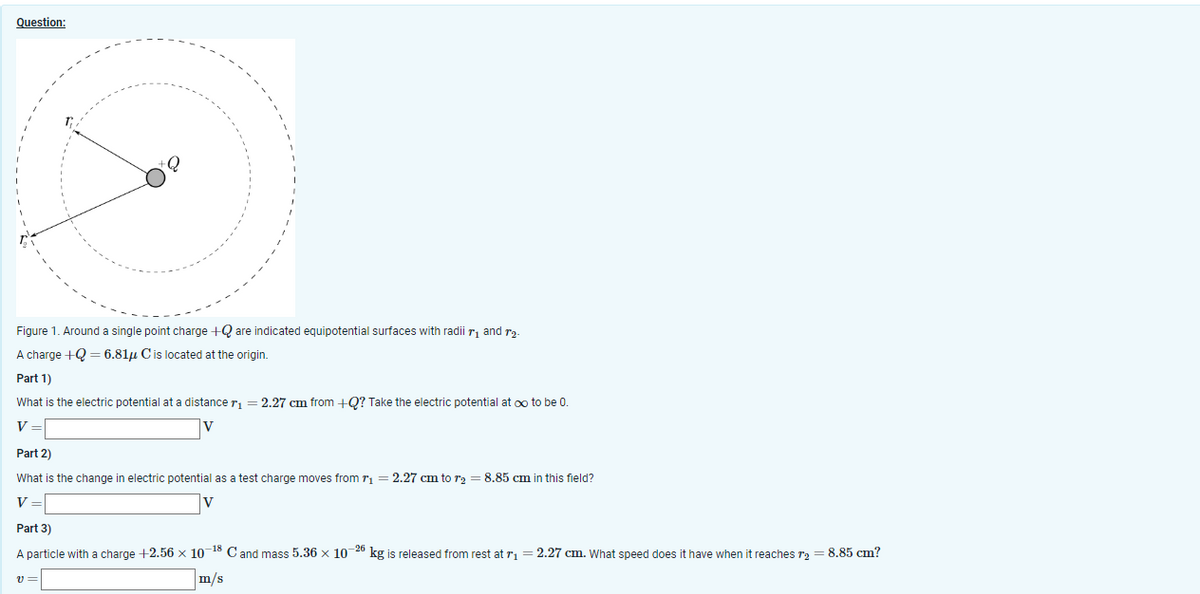Figure 1. Around a single point charge +Qare indicated equipotential surfaces with radii ₁ and 2- A charge +Q=6.81μ C is located at the origin. Part 1) What is the electric potential at a distance r₁ = 2.27 cm from +Q? Take the electric potential at ∞o to be 0. V= V Part 2) What is the change in electric potential as a test charge moves from ₁ = 2.27 cm to r₂ = 8.85 cm in this field? V= Part 3) A particle with a charge +2.56 x 10-18 C and mass 5.36 × 10-26 kg is released from rest at r₁=5 2.27 cm. What speed does it have when it reaches 1₂ = 8.85 cm? m/s V
Figure 1. Around a single point charge +Qare indicated equipotential surfaces with radii ₁ and 2- A charge +Q=6.81μ C is located at the origin. Part 1) What is the electric potential at a distance r₁ = 2.27 cm from +Q? Take the electric potential at ∞o to be 0. V= V Part 2) What is the change in electric potential as a test charge moves from ₁ = 2.27 cm to r₂ = 8.85 cm in this field? V= Part 3) A particle with a charge +2.56 x 10-18 C and mass 5.36 × 10-26 kg is released from rest at r₁=5 2.27 cm. What speed does it have when it reaches 1₂ = 8.85 cm? m/s V
Principles of Physics: A Calculus-Based Text
5th Edition
ISBN:9781133104261
Author:Raymond A. Serway, John W. Jewett
Publisher:Raymond A. Serway, John W. Jewett
Chapter20: Electric Potential And Capacitance
Section20.2: Potential Diff Erence In A Uniform Electric Field
Problem 20.2QQ: The labeled points in Figure 20.4 are on a series of equipotential surfaces associated with an...
Related questions
Question
100%
Please asap

Transcribed Image Text:Question:
30
Figure 1. Around a single point charge + are indicated equipotential surfaces with radii ₁ and 2-
A charge +Q=6.81μ C is located at the origin.
Part 1)
What is the electric potential at a distance r₁ = 2.27 cm from +Q? Take the electric potential at ∞o to be 0.
V =
Part 2)
What is the change in electric potential as a test charge moves from ₁ = 2.27 cm to r₂ = 8.85 cm in this field?
V=
Part 3)
A particle with a charge +2.56 × 10-¹8 C and mass 5.36 x 10-26 kg is released from rest at 7₁ = 2.27 cm. What speed does it have when it reaches 72 = 8.85 cm?
m/s
V
Expert Solution
This question has been solved!
Explore an expertly crafted, step-by-step solution for a thorough understanding of key concepts.
Step by step
Solved in 4 steps with 7 images

Knowledge Booster
Learn more about
Need a deep-dive on the concept behind this application? Look no further. Learn more about this topic, physics and related others by exploring similar questions and additional content below.Recommended textbooks for you

Principles of Physics: A Calculus-Based Text
Physics
ISBN:
9781133104261
Author:
Raymond A. Serway, John W. Jewett
Publisher:
Cengage Learning

Physics for Scientists and Engineers
Physics
ISBN:
9781337553278
Author:
Raymond A. Serway, John W. Jewett
Publisher:
Cengage Learning

Physics for Scientists and Engineers with Modern …
Physics
ISBN:
9781337553292
Author:
Raymond A. Serway, John W. Jewett
Publisher:
Cengage Learning

Principles of Physics: A Calculus-Based Text
Physics
ISBN:
9781133104261
Author:
Raymond A. Serway, John W. Jewett
Publisher:
Cengage Learning

Physics for Scientists and Engineers
Physics
ISBN:
9781337553278
Author:
Raymond A. Serway, John W. Jewett
Publisher:
Cengage Learning

Physics for Scientists and Engineers with Modern …
Physics
ISBN:
9781337553292
Author:
Raymond A. Serway, John W. Jewett
Publisher:
Cengage Learning

College Physics
Physics
ISBN:
9781938168000
Author:
Paul Peter Urone, Roger Hinrichs
Publisher:
OpenStax College

College Physics
Physics
ISBN:
9781285737027
Author:
Raymond A. Serway, Chris Vuille
Publisher:
Cengage Learning

Physics for Scientists and Engineers: Foundations…
Physics
ISBN:
9781133939146
Author:
Katz, Debora M.
Publisher:
Cengage Learning